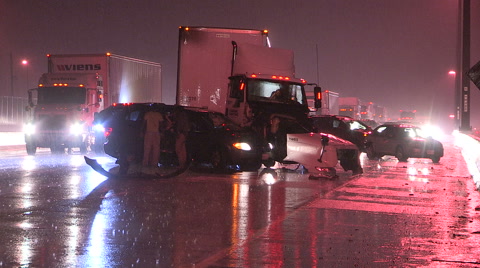
Most truck drivers are professionals who usually operate their rigs safely. In most cases, they cover hundreds of miles over many hours per day, and they do so safely. That said, however, over the years, have been a rather continual increase in the number of truck accidents on Texas roads and beyond.
Why Truck Drivers Like to Drive at Night
One of the key reasons for the constant increase seems to be the large number of truck drivers who seem to prefer to drive at night, primarily because traffic is lighter. Unfortunately, while there are fewer vehicles on the road at night, the conditions are such that they should be more vigilant. For example, one of the key issues truck drivers face when driving after dark is fatigue, especially if they’ve already been driving for a while during the day. At night, the body naturally wants to sleep, which makes it a challenge to operate a large vehicle pulling tons of extra weight. That is why they must be sure they have received adequate rest before a night voyage.
Another common issue many truck drivers have is a less-than-optimal ability to see during the night. Such “night blindness” can become worse with age, and it is also made worse when combined with the glare of oncoming traffic. Whenever this happens, even for a second or two, a large truck may go a significant distance before they are able to react.
Fatigue due to a lack of sleep is a serious problem and causes a lot of truck accidents. It is also one that is made worse by sleep apnea. The U.S. Department of Transportation estimates that up to 28 percent of truck drivers may have sleep apnea. In addition to that, the National Highway Transportation Safety Administration (NHTSA) estimates that as many as 83,000 accidents are tied to drivers who actually doze off behind the wheel. That number includes almost 886 fatal and 37,000 injury crashes, as well as an estimated 45,000 auto accidents that only cause property damage. Overall, nationwide, driver fatigue is cited as a factor in 40 percent of all truck crashes. That number demonstrates how dangerous the roads are for those who share the road with sleep-deprived truck drivers.
According to a study conducted by the Harvard School of Medicine’s Sleep Medicine Division, nearly half of semi-truck drivers who responded admitted to having actually “drifted off” while driving during a long-haul route. Given the lack of light in many places, driving at night is already inherently dangerous; when you add in fatigue, encountering large trucks on the road becomes even more of a risk.
Steps Taken to Limit Truck Accidents at Night
The U.S. Department of Transportation, along with the Federal Motor Carrier Safety Administration (FMCSA) has stiffened regulations in response to a growing concern or semi-truck accidents caused by drowsy drivers. There are many factors leading to nighttime truck accidents, including irregular hours with early start times, long driving hours, the natural disadvantages of night-time driving, tight scheduling, and insufficient time for recovery, At one time or another, these federal agencies have created regulations to address all of those. For example, the FMCSA mandated a new hours-of-service regulation to prevent driver fatigue. The new hours of service include:
- A maximum of a 14-hour workday and a daily driving limit of 11 hours.
- Limits the maximum average workweek for truck drivers to 70 hours. Previously, drivers were limited to 82 hours per week.
- Truck drivers who reach the maximum 70 hours of driving within a week may resume driving only if they get a minimum of 34 hours (consecutive) of rest. That 34 hours must include two nights.
- It requires truck drivers to take a 30-minute break during the first eight hours of a shift.
Companies who fail to follow these rules are subject to an $11,000 fine per offense, while the drivers themselves could face civil penalties of up to $2,750 for each offense.
Despite these regulations and the potential of such stiff penalties, and with drivers required to log their driving hours, many companies and drivers continue to slip through the cracks, with many companies continuing to pressure their drivers to cut corners and complete deliveries that are in fast-demand.
The Risks of a Dark Road at Night
Drivers who tend to operate at night face a lesser ability to see adequately, even with the assistance of road lights and headlights. The black road is very dark and blends in with the surroundings, which means only street signs and road markings to go on in finding their destination. Even the best-lit roads are not as visible as they are in daylight, and the directionality of street lights and headlights create shadows, which can hide potential dangers or create false perceptions of hazards. Besides that, headlights from other vehicles create glare and can sometimes temporarily blind drivers. Also, if their windshield is dirty, the marks on the glass throw off the driver’s perceptions of the surrounding area.
In other words, the physical environment encountered when we drive at night is inherently risky, but that is only the tip of the iceberg. How long truck drivers operate is an essential consideration because driving for a long time is hard on the body. In fact, even with the current regulations, driving for 11 hours straight is very physically draining. By the 11th hour of driving, a truck driver is exhausted, especially at the end of a long week, regardless of their level of experience. That means their reaction time is slower, their vision is slightly blurred and their memory is not as sharp as normal. All of this has the potential to lead to semi-truck vs passenger vehicle accidents where any fatality is likely to be those riding in the passenger vehicle.
